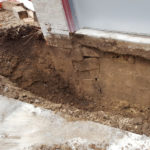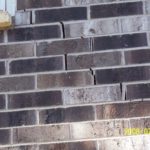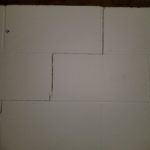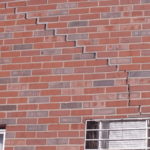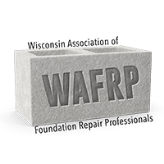Mequon Foundation Repair
If you see signs like wall cracks or bowing and cracking in new or old foundations, this can be a serious problem we will want to address right away. We are the go-to Mequon foundation repair company.
Foundation Wall Cracks
When ground water saturation occurs in the freeze thaw periods of winter, the ground expands, creating tremendous pressure on below ground portions of the foundation walls. This stress overtime fractures the wall. According to the Home Inspection Census more than 50% of all basement foundation walls have a good chance of cracking or bowing in the winters to come!
When looking at foundation walls if they appear cracked, you have visual confirmation that your concrete block / cinder block walls have water trapped inside the blocks. Additionally, it is highly likely that you have at least occasional basement leaks, moisture wicking through the blocks into the air in your basement causing a damp basement, and/or water entering your home beneath the basement floor slab, and unfortunately, the ideal conditions for the premature deterioration of your foundation walls. There are two ways to solve this problem depending on the severity of the issue: have your block foundation walls waterproofed from the outside and/or drain-tile removal and replacement from the inside. We only use quality waterproofing products that will put an elastomeric membrane on the wall not a cheap tar that will dry out.
Bowing and Cracking in new and old foundations
Bowed and cracked basement walls can be very serious signs of structural damage to the foundation. Traditional methods of addressing these issues include using steel beams, carbon fiber, tiebacks, piering, excavation and repair or replacement of the foundation wall.
Cinder Block Foundation Repair
Cracked Block Foundation Indicates lateral pressure on the walls. Serious movement can be seen in stair step and horizontal cracks in mortar joints.
Cracks in Poured Concrete Typically occurs within 30 days of the concrete curing process. Usually a very simple repair is using epoxy injection system for welding cracks back together. This all can be done on the inside without excavation or major disruption to basement areas. This process can be hours not days. However, in combination with other signs could be a more serious sign of settlement.
Carbon Fiber/Kevlar Strap System
Replacing the use of Steel with Carbon Fiber Carbon Fiber is now a proven popular alternative to steel for reinforcing structural substrates in residential and commercial concrete applications. Carbon fiber is highly effective at adding tensile strength to concrete. It is superior to steel since it is stronger, stiffer and non-corrosive. It can be bonded to the surface of a concrete structure at any time to stop bowing and cracking. This allows limitless applications for new construction, repair, retrofit and seismic upgrades. The unique Fortress Carbon Fiber/Kevlar Grid System delivers properties unmatched in the market today. The patented Fortress Grid Strap is the only pre-cured product that is fully encapsulated in epoxy. Others are simply glued onto the wall and can peel off. Every hole in the grid allows the outer epoxy to touch the inner epoxy rivet. These rivets act as rip stops preventing the grid from peeling off. In addition it allows for visual inspection for resin voids and air pockets.
Chimney Cracking or Leaning Often, chimneys are built on independent footers. Therefore, cracking and leaning usually indicate movement in this particular footer. A more severe problem would be foundation movement disturbing this independent footer.
The Mudjackers had an emergency call from a contractor that was excavating for an addition on an old house in Walworth county, as the excavator was digging for the new foundation walls the chimney started to pull away from the house. The excavating company had to hold the chimney from falling over with their excavator. After many calls to multiple companies that could not help the contractor they called The Mudjackers, our crew was able to install two helical piles on the chimney that stabilized and tilted the chimney back into place. Once completed the contractor encapsulated the piers and the rest of the foundation with concrete walls to tie all of the structure together.
Sinking Foundation This is perhaps the most serious sign of settlement. The foundation sinks because it is separating from the building structure. This must be taken care of as soon as possible or may lead to wall collapse.
In a recent case, a foundation damage was due to a broken sewer line, the sewer line washed out the ground under the footing of the house causing the footing to tilt and settle. The Mudjackers repair scope was to excavate the wall, remove the part of wall that affected by the settling, support the underside of wall, install helical piles to support new and old foundation wall areas, form and pour a solid poured grade beam wall on top of helical piles to underside of block wall. Install steel beams for additional horizontal strength and backfill with no. 1 stone to grade.
Drywall Cracks Shifts in the foundation often because other cosmetic damage inside the building. Drywall cracks around windows, doorframes, and in corners are common symptoms of significant foundation movement
Uneven Doors and Windows Another typical indication of foundation shifting. Shifting could cause framework to contort out of square, leading to windows and doors sticking or not opening and closing properly.

